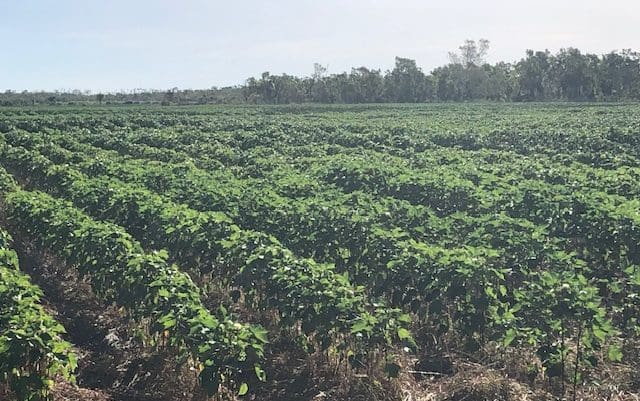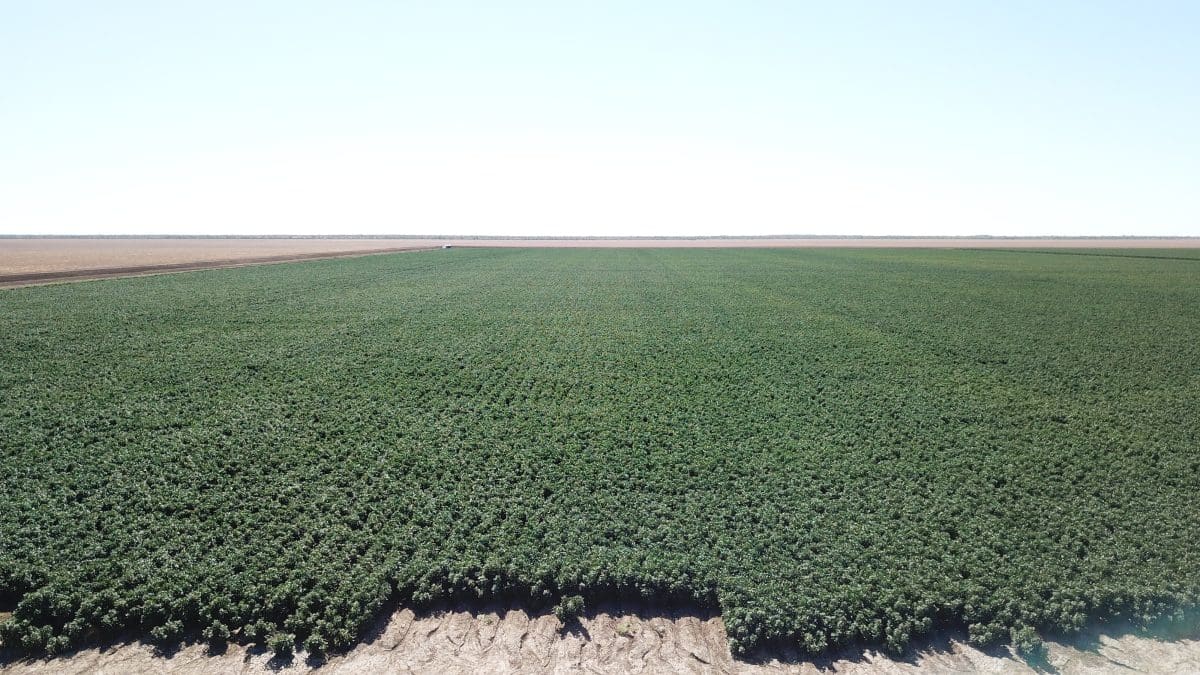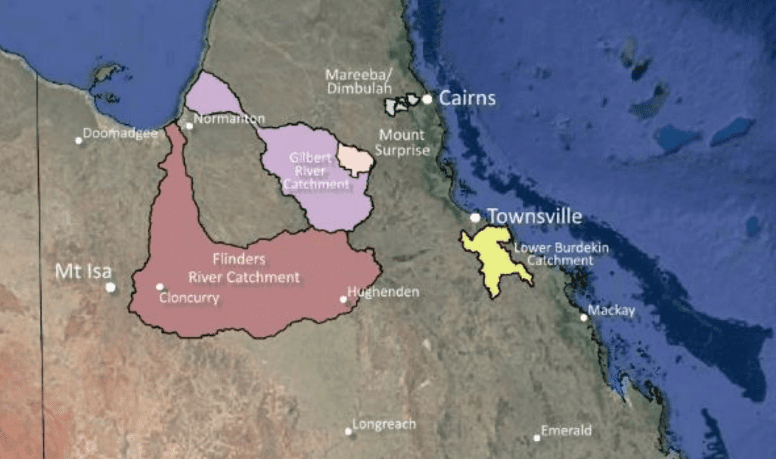
North Queensland dryland cotton suffering from moisture stress in March 2022. Photo: supplied
With the North Queensland cotton harvest at least a month away, irrigated cotton growers are currently predicting good yields while the rainfed crops are seeing lackluster early results off the back of below-average February and March rainfall.
The below-average rainfall has not dampened interest in the industry, with North Queensland cotton crop still expected to see continued growth in the coming years.
Cotton Seed Distributors extension & development agronomist Sam Lee said below-average rainfall in the wet season has increased the yield divide between dryland and irrigation.
“It has certainly been a dry wet season, so any of the dryland or rain-grown crops have unfortunately been quite affected and they are probably not going to have great yields,” Mr Lee said.
“On the flip side, there is going to be some reasonably good irrigated crops if the season finishes well, because there has been less wet-season weather and there has been less cloudy weather.
“Those irrigated crops that have had water to supplement them are looking quite good.”
He said the late-season falls in eastern parts of northern Queensland may work against the development of some cotton crops.
“They are getting quite a wet season event to the east at the moment; that is the risk for the more eastern crops that if they get 10 days of cloudy weather that could still affect their yields.”
With about 80 per cent of crops reliant on rain, the dry wet season will be hitting most cotton growers.
Atherton Tablelands mixed farmer Brad Jonsson said his 650-hectare rainfed crop suffered from the below-average rainfall, but that the plants still produced some fruit.
“It has been the driest wet season since we started keeping records 25 years ago,” Mr Jonsson said.
“We got a decent amount planted, but there was not enough follow-up rain to get a reasonable crop.
“It won’t be too bad; we will still get about three bales to the hectare if we are lucky.”
Mr Jonsson said this season was unusual for the region and the reduced yields won’t stop him, or other growers, from planting another cotton crop.
“Usually, 90pc of the time you get a reliable wet season, but this year it just didn’t happen.
“It won’t deter us; we will back up again next year and plant the same amount of area.”
Irrigated crops positive
Grower Lucas Findley, who has an irrigated property near Julia Creek in north-west Queensland, said overall he was pleased with the development of the 700ha 2022 crop.
Mr Findley, who also grows cotton at Wee Waa in New South Wales, said this was only his second crop at Julia Creek and he was still learning about growing cotton in the tropics and the intricacies of his property and soil types.
“We’ve got some cotton in – some looks good and some looks bad – but it’s mostly positive and we happy are with what we are seeing,” Mr Findley said.
“We grew cotton last year, which we were quite happy with, a lot smaller scale of course, but it harvested well.
“We can always push the crop more; there is nothing telling us what we are doing is a silly idea – it’s all very positive.”

A thriving 2021 North Queensland irrigated cotton crop. Photo: supplied.
Learnings from unusual season
Nutrien Ag Solutions Mareeba and Tolga branch manager Thomas Mugford said, despite the disappointing summer rainfall, the early crop progression demonstrated what was possible with cotton in the north.
“We were looking at a cracker season; it was going to be unbelievable, then we had that dry February and March,” Mr Mugford said.
“It is far from a disaster; there are some crops that are exceptional and some crops that are mediocre, but overall.
“Even though the season went badly from a moisture perspective, some of that cotton, when I walked through it, I just couldn’t believe how that plant hangs on and taps into moisture.
“If that is what we can do in a really bad year, just imagine when we get the perfect season – it will be absolutely incredible.”
Mr Mugford said growers and agronomists will be able to take away new data and learnings from the unusual season to inform future decisions.
“In terms of the dryland crops, a positive that could be taken from the season is that because cotton is so new to the north, we are learning so much.
“There is no textbook about it, and there has been a lot of learnings this year about plant population and about timing of planting.
“We are getting better and better growing the crop in North Queensland every year.”
Strong demand for gin
The exponential growth of the industry in the past five years prompted local government-backed organisation Mount Isa to Townsville Economic Development Zone (MITEZ) to develop a feasibility study examining the viability of a gin in North Queensland.
Released last year, the document considered several locations for a gin, but identified Richmond, Hughenden and Mount Surprise as preferred centres for the proposed processing facility.

North Queensland cotton gin feasibility study identified possible sites for a new operation. Photo: MITEZ
It also theorised that, with current levels of growth, annual production could expand from around 26,750 bales at present to 202,810 bales in just five years.
The report found that to continue this increase in production, large-scale water infrastructure would be needed to support growth in irrigated production.
This included the Gilbert River Irrigation Project, Richmond Agriculture Project and the Hughenden Irrigation Project.
Mr Lee said confidence was growing for tropical cotton, with the amount planted expanding every season.
He said this growth was making the proposition for a gin in the region more attractive for investors.
“The area has been steadily growing the last three or four years.
“If [growers] are still able to break even or get close, even with having to freight their cotton down to Dalby or Emerald, once the infrastructure gets built up there, that will make it easier again for them.”
Gin to cut freight costs
Mr Findley said, as an established grower, he factored freight costs into his business plan.
He said reducing these expenses would encourage more farmers to grow cotton.
“I’m extremely confident about this region there’s no doubt about that.
“We have done all our numbers on a gin being there and with the freight costs, which are very extreme.
“If a gin comes, then it is just going to opening it up for a lot more people.
“It is a significant cost, but it will come.”
Mr Findley said he believed the dryland growers will see the most financial benefits from having a gin located in closer proximity to the farm gate.
“The true potential up north is the dryland; that is where the big-scale potential is.
“Irrigation will be the catalyst for the dryland industry, because it will draw the agronomists, it will draw the cotton gin and the grain-handling facilities.
“On the back end of that, it will make dryland more viable and that’s where the true potential is, it’s not the irrigation.
“If you can cut the costs down for the dryland grower it makes it absolutely viable.”
Namoi backs idea
Grower confidence in the industry has prompted Australian ginner and marketer Namoi Cotton to get on board and consider options for building a facility in North Queensland.
The company has already invested in the proposed Kimberley gin and is taking further steps to diversify operations into in Western Australia.
As a part of the 2022 financial results presentation last week, Namoi Cotton executive general manager of strategy and business development, Neil Johns, said Namoi was exploring options for a northern gin.
“Many growers, including our growers from NSW, have moved up north to pursue opportunities up there,” Mr Johns said.
“We are in discussions with a number of growers there to look at options for a joint venture gin.
“There is huge potential there and we are working with the local growers and Councils to use our capacity and capability.”
It is predicted that northern Australia, including WA, Northern Territory and northern Queensland, will produce about 160,000 bales this season.
According to Namoi Cotton, this could increase to over 400,000 bales in five years.
Cotton Australia has forecasted that the upcoming national cotton crop could be as large as 5.2 million bales.
This is up from the 2020-21 yield of 2.8 million bales.
Grain Central: Get our free news straight to your inbox – Click here

HAVE YOUR SAY